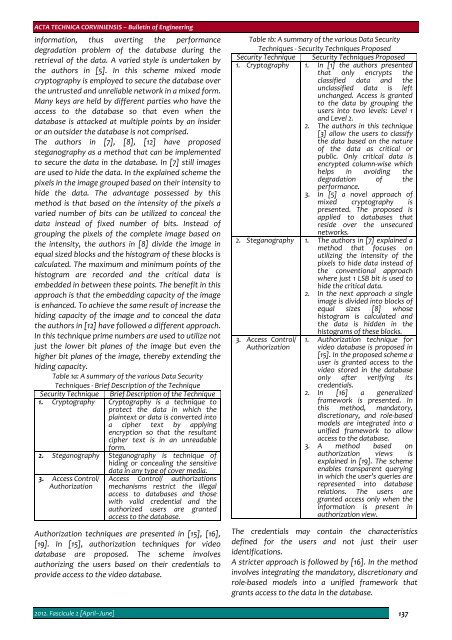Editorial & Advisory Board - Acta Technica Corviniensis
Editorial & Advisory Board - Acta Technica Corviniensis
Editorial & Advisory Board - Acta Technica Corviniensis
Create successful ePaper yourself
Turn your PDF publications into a flip-book with our unique Google optimized e-Paper software.
ACTA TECHNICA CORVINIENSIS – Bulletin of Engineering<br />
information, thus averting the performance<br />
degradation problem of the database during the<br />
retrieval of the data. A varied style is undertaken by<br />
the authors in [5]. In this scheme mixed mode<br />
cryptography is employed to secure the database over<br />
the untrusted and unreliable network in a mixed form.<br />
Many keys are held by different parties who have the<br />
access to the database so that even when the<br />
database is attacked at multiple points by an insider<br />
or an outsider the database is not comprised.<br />
The authors in [7], [8], [12] have proposed<br />
steganography as a method that can be implemented<br />
to secure the data in the database. In [7] still images<br />
are used to hide the data. In the explained scheme the<br />
pixels in the image grouped based on their intensity to<br />
hide the data. The advantage possessed by this<br />
method is that based on the intensity of the pixels a<br />
varied number of bits can be utilized to conceal the<br />
data instead of fixed number of bits. Instead of<br />
grouping the pixels of the complete image based on<br />
the intensity, the authors in [8] divide the image in<br />
equal sized blocks and the histogram of these blocks is<br />
calculated. The maximum and minimum points of the<br />
histogram are recorded and the critical data is<br />
embedded in between these points. The benefit in this<br />
approach is that the embedding capacity of the image<br />
is enhanced. To achieve the same result of increase the<br />
hiding capacity of the image and to conceal the data<br />
the authors in [12] have followed a different approach.<br />
In this technique prime numbers are used to utilize not<br />
just the lower bit planes of the image but even the<br />
higher bit planes of the image, thereby extending the<br />
hiding capacity.<br />
Table 1a: A summary of the various Data Security<br />
Techniques ‐ Brief Description of the Technique<br />
Security Technique Brief Description of the Technique<br />
1. Cryptography Cryptography is a technique to<br />
protect the data in which the<br />
plaintext or data is converted into<br />
a cipher text by applying<br />
encryption so that the resultant<br />
cipher text is in an unreadable<br />
form.<br />
2. Steganography Steganography is technique of<br />
hiding or concealing the sensitive<br />
data in any type of cover media.<br />
3. Access Control/<br />
Authorization<br />
Access Control/ authorizations<br />
mechanisms restrict the illegal<br />
access to databases and those<br />
with valid credential and the<br />
authorized users are granted<br />
access to the database.<br />
Authorization techniques are presented in [15], [16],<br />
[19]. In [15], authorization techniques for video<br />
database are proposed. The scheme involves<br />
authorizing the users based on their credentials to<br />
provide access to the video database.<br />
Table 1b: A summary of the various Data Security<br />
Techniques ‐ Security Techniques Proposed<br />
Security Technique Security Techniques Proposed<br />
1. Cryptography 1. In [1] the authors presented<br />
that only encrypts the<br />
classified data and the<br />
unclassified data is left<br />
unchanged. Access is granted<br />
to the data by grouping the<br />
users into two levels: Level 1<br />
and Level 2.<br />
2. The authors in this technique<br />
[3] allow the users to classify<br />
the data based on the nature<br />
of the data as critical or<br />
public. Only critical data is<br />
encrypted column‐wise which<br />
helps in avoiding the<br />
degradation<br />
performance.<br />
of the<br />
3. In [5] a novel approach of<br />
mixed cryptography is<br />
presented. The proposed is<br />
applied to databases that<br />
reside over<br />
networks.<br />
the unsecured<br />
2. Steganography 1. The authors in [7] explained a<br />
method that focuses on<br />
utilizing the intensity of the<br />
pixels to hide data instead of<br />
the conventional approach<br />
where just 1 LSB bit is used to<br />
hide the critical data.<br />
2. In the next approach a single<br />
image is divided into blocks of<br />
equal sizes [8] whose<br />
histogram is calculated and<br />
the data is hidden in the<br />
histograms of these blocks.<br />
3. Access Control/<br />
Authorization<br />
1. Authorization technique for<br />
video database is proposed in<br />
[15]. In the proposed scheme a<br />
user is granted access to the<br />
video stored in the database<br />
only after<br />
credentials.<br />
verifying its<br />
2. In [16] a generalized<br />
framework is presented. In<br />
this method, mandatory,<br />
discretionary, and role‐based<br />
models are integrated into a<br />
unified framework to allow<br />
access to the database.<br />
3. A method<br />
authorization<br />
based<br />
views<br />
on<br />
is<br />
explained in [19]. The scheme<br />
enables transparent querying<br />
in which the user’s queries are<br />
represented into database<br />
relations. The users are<br />
granted access only when the<br />
information is present in<br />
authorization view.<br />
The credentials may contain the characteristics<br />
defined for the users and not just their user<br />
identifications.<br />
A stricter approach is followed by [16]. In the method<br />
involves integrating the mandatory, discretionary and<br />
role‐based models into a unified framework that<br />
grants access to the data in the database.<br />
2012. Fascicule 2 [April–June] 137

















